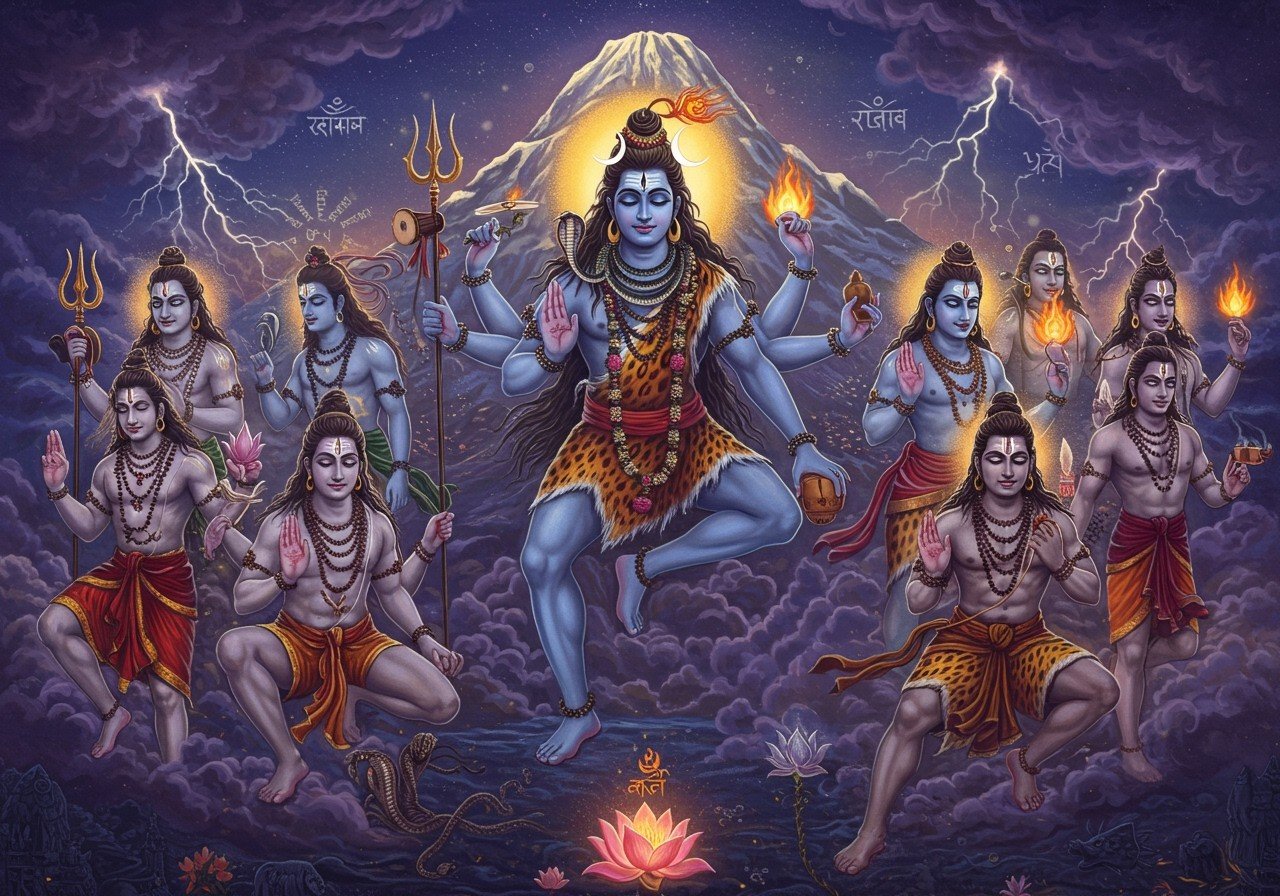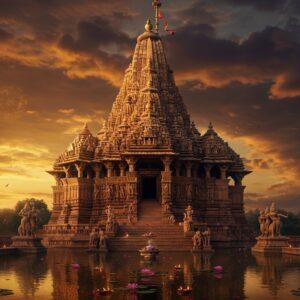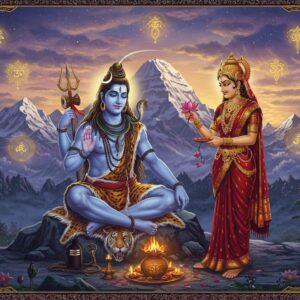
In Hindu mythology, the Rudras hold a significant position, deeply embedded in spiritual practices and traditions. They are not merely mythical figures, but powerful deities representing profound concepts. This article explores their origins, significance, and role in Hinduism, providing a deeper understanding of these complex deities.
Who Are the Rudras?
The Rudras are a group of deities associated with storm, wind, and hunting. They are considered manifestations of Rudra, an early form of Lord Shiva. The name ‘Rudra’ itself means ‘the roarer’ or ‘the howler,’ indicative of their fierce nature. Depicted in the Rigveda as powerful and awe-inspiring, they embody both destructive and benevolent qualities, symbolizing the dual nature of the universe. Often linked to the Maruts, another group of storm deities, the Rudras play a vital role in maintaining cosmic order. They are fierce and unpredictable, reflecting the raw power of nature.
The Concept and Symbolism of the Rudras
In Hinduism, the Rudras transcend mere divine figures; they embody deep philosophical ideas. Connected to the natural world, they symbolize the cyclical nature of life, death, and rebirth, reflecting the continuous flow of existence. This close association with nature highlights the Rudras’ representation of the fundamental elements of life. Their evolution from Vedic to Puranic literature demonstrates the changing interpretations of their roles and attributes over time. They are fundamental forces, shaping the world around us.
The Rudras are also linked to the Panchabhuta, the five elements: earth, water, fire, air, and space. This emphasizes their importance in rituals and spiritual practices, as they represent the building blocks of creation. As protectors of the cosmos, they maintain dharma, or moral order, upholding the balance between good and evil. This cosmic duty showcases their dual role in both destruction and creation, maintaining equilibrium in the universe.
Artistic and cultural representations of the Rudras are equally captivating. Temple sculptures and paintings often depict these deities in powerful and dynamic forms, reflecting their significance and the reverence they command within Hindu tradition. These depictions serve as visual reminders of their power and presence in the spiritual realm.
How Many Rudras Are There?
The number of Rudras varies across different texts and traditions. The most commonly accepted number is eleven. The significance of the number eleven relates to Hindu cosmology and offers insights into the mystical world of numbers and their meanings. It represents the ten vital energies (rudra-prana) in the body and the eleventh being the Ātman (the soul), according to the Brihadaranyaka Upanishad. This numerical representation connects the Rudras to the very essence of life within individuals.
Key scriptures such as the Shiva Purana and Vishnu Purana offer different accounts of the Rudras, reflecting diverse philosophical interpretations and regional beliefs within Hinduism. These variations enrich the understanding of these deities and their multifaceted nature. Mythological stories about their birth and deeds further add depth to their existence, providing context for their importance in Hindu mythology. These tales weave a rich tapestry of belief and tradition, adding layers of meaning to their significance.
The Role of Rudras in Hindu Rituals and Worship
The Rudras play a central role in various Hindu rituals and prayers. The Rudram Chamakam, a revered hymn from the Yajurveda, is specifically dedicated to invoking their blessings, highlighting their importance in spiritual practices. This hymn is a powerful invocation, seeking the benevolent aspects of these deities.
During festivals like Maha Shivaratri, Rudras are worshipped alongside Lord Shiva, underscoring their connection to this major deity and their role in maintaining cosmic balance. Ritualistic practices involving the Rudras often incorporate fire sacrifices (Yagnas) and specific temple architecture. This signifies their symbolic presence and the importance of honoring them through prescribed rituals. The architecture itself often reflects the symbolic power of the Rudras, further emphasizing their importance.
Regional variations in Rudra worship across India reflect the diverse cultural tapestry of Hinduism. These differences enrich the understanding of how the Rudras are integrated into local traditions, enhancing their role in people’s spiritual lives. These variations demonstrate the adaptability and continued relevance of these deities across diverse communities.
How Poojn.in Can Help You Honor the Rudras
At Poojn.in, we offer a wide selection of authentic puja items to help you perform Rudra-related rituals with reverence and devotion. We understand the importance of using genuine and high-quality products for your spiritual practices. Browse our collection of items specifically curated for Rudra puja, including:
- Pure copper and brass items for Rudra abhishek. These items are crafted with precision and care, ensuring their suitability for sacred rituals.
- Traditional rudraksha malas in various sizes. Choose from a selection of genuine rudraksha beads known for their spiritual significance.
- High-quality bilva leaves for Rudra puja. Sourced fresh and handled with care, these leaves are essential for offerings to Lord Shiva and the Rudras.
- Pure silver items for ritual offerings. These items add a touch of purity and devotion to your worship.
- Authentic panchamrit ingredients. Prepare the sacred panchamrit with genuine ingredients for a truly blessed offering.
- Special puja thalis for Rudra worship. These thalis provide a dedicated space for your offerings, enhancing the sanctity of your rituals.
Visit www.poojn.in today to explore our complete collection of Rudra puja items and other spiritual products. We offer pan-India delivery and secure payment options for your convenience. As India’s largest Dashakarma Bhandar, we are committed to providing authentic and high-quality items for all your religious needs.
Embracing the Legacy of the Rudras
The Rudras hold a unique and profound place in Hinduism, weaving together nature, philosophy, and spirituality. Their presence in scriptures, rituals, and art reflects their role as cosmic guardians and vital life forces. Understanding the Rudras provides insights into the rich traditions and beliefs that have shaped Hindu culture for centuries. They serve as a powerful reminder of the intricate connections within the universe.
These divine figures symbolize the balance between creation and destruction, life and death, reminding us of the cyclical nature of existence. Their significance in rituals like the Rudram Chamakam and festivals such as Maha Shivaratri highlights their enduring influence on Hindu practices. By exploring the diverse interpretations and stories surrounding the Rudras, we gain a deeper appreciation for their crucial role in our spiritual heritage.
Embracing the legacy of the Rudras allows us to honor the past while enriching our spiritual journey in the present. As we continue to celebrate and understand these powerful deities, we maintain the traditions that connect us to our cultural identity and spiritual roots.


